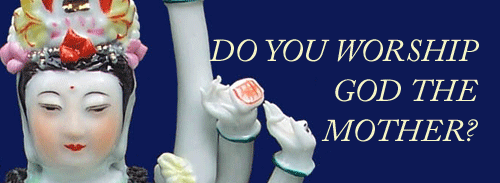I Believe in God the Mother
The Filianic Creed
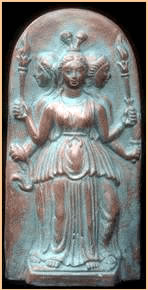
"I believe..." The reiterated statements of the Filianic Creed make a concise and beautiful statement of the devotion and thealogy of those who believe in the feminine Holy Trinity.
Filianists (or Daughter-believers) hold this to be the perfect statement of faith, as well as a perfect Act of Devotion, for these late years of Kali Yuga.
The Filianic Creed will be familiar to those who have attended a Filianic (Daughter-worshipping) Service. These have been held for many years in private houses and are currently held online at the four great Daughter-Festivals of the year.
The Filianic Creed
I believe that I am created
from before the dawn of time
by the one eternal Dea.
I believe that Dea is One
and there are none beside Her,
And I believe that She is also Three.
I believe in the Mother,
Who is pure Light,
the Creatrix of the earth and of the heavens
and of all the illimitable cosmos.
And I believe in Her virgin Daughter,
born of the virgin Mother,
the ruler of all the energies of creation,
Whose nature is perfect Love.
And I believe in She that stands beyond these Two,
Whose Name has not been spoken on this earth:
For She is the Beginning and the End;
the First Principle and the Final Cause;
the unoriginated Origin of being.
I believe that I was made a perfect creature
and at the dawn of time my soul did turn
from the Perfection of existence
in the infirmity of her sovereign will:
And through this fault do I suffer
the limitation of imperfect being.
I believe that the Daughter of Eternity
gave herself to be cast down into darkness and death.
I believe that She rose from death triumphant
And reigns as Queen of Heaven.
I believe that through Her death
the fault of my soul shall perish,
And I believe, through Her triumphant life,
My soul shall rise renewed in her perfection
that she may return to eternal communion
with the one eternal Dea.
Commentary
A brief explanation of the Eight Statements of the Filianic Creed
I believe that I am created
from before the dawn of time
by the one eternal Dea.
Thus begins what, on the microcosmic level, can be called the history of the Soul and, on the macrocosmic level, the History of Time.
It makes clear the eternal nature of the soul and of her Creatrix.
Each of us has always existed as a fragment of the all-reality that is God the Mother. She is our true home and Point of Origin.
When time began and things existed in separation from God, the separation of individual existence also became possible, with all its attendant joys and suffering.
This first statement of the Creed also makes clear the fact that Dea comes first: before all things; before time; before being itself.
Many modern people try to explain God as a creation of the human mind. But She created the human mind as well as with every other thing in existence. If there are certain similarities between our ideas of the Divine and ourselves, it is because we originated in Dea; not because Dea originated in us.
This First Statement gives the conclusive answer of the devotee to all "psychological explanations of religion". God does not come from our minds. Our minds come from God.
I Believe... continues after break
I believe that Dea is One
and there are none beside Her,
And I believe that She is also Three.
That God is One and also Three is the central statement of Trinitarian doctrine. The Christian theologian, St. Augustine mocked pagan worshippers for believing that God the Mother is One and also three, but after his conversion, came to defend the patriarchal version of the same doctrine.
The statement that there are none beside Her makes it clear that Dea is the one Supreme being: the Absolute. There can no more be two Absolutes than a circle can have two centres.
While we believe that Dea has many Names and Aspects (much of this site is devoted to the study of those Names and Aspects), and also believe that there are great Angelic Beings (or Janyati) who do Her work, the thing which certain patriarchal religions like to term "polytheism", or the belief that there can be more than one God, is a metaphysical absurdity that no authentic religious tradition has ever believed.
"Polytheism" in the sense that Christians and Moslems use it, is no more than a semantic confusion. Some languages use terms like thea, devi or dea to mean both the Supreme Being and Her lesser aspects. This has never – except possibly at very degenerate stages of certain cultures – implied that there could be more than one Supreme Being, which would clearly be a spiritual and metaphysical absurdity.
"There are None beside Her" also rules out the male "consorts" introduced by patriarchal and semi-patriarchal cults. Since Dea is the absolute, She can have no consort, for She Herself is All in All.
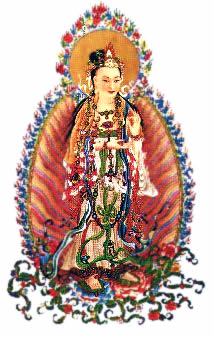
I believe in the Mother,
Who is pure Light,
the Creatrix of the earth and of the heavens
and of all the illimitable cosmos.
The First Person of the Holy Trinity is God the Mother. She is the first thing that we can know, for before Her there is no time and no space: no things of any sort. She is the Creatrix of all, the origin of everything we can know.
She is Light, because without Her nothing would be visible. She is the Supreme Intelligence (mati) or Light of the universe. She is the Supreme Consciousness. Every other consciousness is but a fragment of Her Consciousness.
Just as the sun is the source of all light in our world (the moon's light is the reflected light of the sun, and even fire is only the release of the solar energy that made possible the growth of wood or other combustible material), so the Supernal Sun is the source of all spiritual Light. God the Mother is that Supernal Sun.
All things, both earthly and heavenly, begin in God the Mother. She is both the Origin of all things and the Light by which we see them. All true science must begin with Dea, which is why thealogy is called the Queen of the Sciences.
And I believe in Her virgin Daughter,
born of the virgin Mother,
the ruler of all the energies of creation,
Whose nature is perfect Love.
As maid was separated from Dea, Her absolute Light became "too great for us to look upon". Thus, in Her infinite compassion, She gave birth to a Daughter Who was "not separate from Her, but One with Her, and the Child of Her Light".
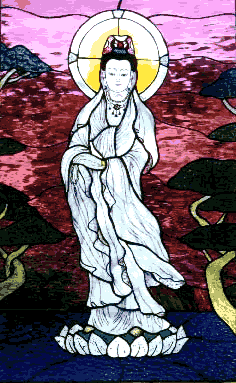
Just as we cannot look upon the sun, but the moon reflects the solar light in a radiance we may gaze upon, so the Daughter reflects the light of the Mother upon us in a gentle form, tempered kindly to our human frailty.
The Daughter mediates the Light of the Mother not only to maid, but to all creation. Strictly, a creation that existed in separation from Dea could not exist, for She is its sole Source of being; yet creation (or manifestation) itself is by definition the development of things other than God.
The Daughter resolves this paradox by mediating the Divine Light to a non-Divine creation. Thus she is the Preserver of the Worlds and the controller (thamë) of all the lesser energies that sustain them in being.
Since this is the supreme Act of Compassion, the Daughter is called pure Love (sushuri) just as the Mother is pure Light (mati).
The two radiances of the sun are warmth and light. In traditional pictures that show the sun's rays as alternately straight and wavy, the straight lines represent light and the wavy lines represent warmth.
Thus, while the Mother and the Daughter are the Supernal Sun and the Supernal Moon respectively, their Divine Activity may also, on a certain level, be regarded as the two solar Functions. The Mother is the Supreme Light, or intelligence and the Daughter the Supreme Love, or warmth.
The stress upon the virginity of both Mother and Daughter emphasises the fact that they are beyond material manifestation (though they are its sole Cause) and also refutes the patriarchal and semi-patriarchal cults that have invented a male consort for either Mother or Daughter.
And I believe in She that stands beyond these Two,
Whose Name has not been spoken on this earth:
For She is the Beginning and the End:
the First Principle and the Final Cause;
the unoriginated Origin of being.
The Dark Mother is so called because we can know nohting of Her. As with the Upanishadic doctrine of the Absolute, we can only say of Her neti, neti: "not that, nor that". Or as the Chinese formulation has it: "the Tao that can be spoken of is not the true Tao". She is the true Object of all that is called "negative thealogy".
While the Light of God the Mother reveals all that is intelligible, the Darkness of the Dark Mother conceals all that is beyond intelligibility. In truth, though, it conceals nothing, for the seeming-darkness is really only our inability to see, so long as we remain upon the Wheel of Werde – the flux of samsara.
She is called "Dark beyond the Light and Light beyond the Darkness" because she is that which lies beyond the bright Light even of our dear Mother, and yet within Her apparent Darkness lies the greatest Light of all.
From the human perspective, She is the Third Person of the Trinity, but from the Celestial perspective, She is the First Person.
These paradoxes do not need to trouble us, for the beautiful Light of the Mother and the all-nurturing Love of the Daughter are the proper objects of our devotion.
Indeed, we would treat with great caution any who claimed to be a follower of the Dark Mother unless she showed signs of truly exceptional spiritual advancement and complete detachment from the things of this world.
I believe that I was made a perfect creature
and at the dawn of time my soul did turn
from the Perfection of existence
in the infirmity of her sovereign will:
And through this fault do I suffer
the limitation of imperfect being.
Having declared our faith in the Holy Trinity, we return to the History of the Soul, begun in the First Statement of the Creed.
Every spiritual tradition agrees that the Problem of Maid is her separation from the Absolute. Buddhism speaks of the dukkha (suffering) caused by our being bound to the worlds of relativity and change (samsara). The Abrahamic traditions speak of the loss of the Garden of Eden. Hindus strive for union (yoga) with the Absolute, which, they would fervently agree, is actually a re-union.
Here the Filianic Creed speaks of the Problem of Maid. It speaks of our original perfection and of our turning from Dea. That turning is, a complex thealogical question which we will not attempt to discuss fully here.
Different traditions regard this separation – the Problem of Maid – differently. Eastern traditions (and the ancient Greeks) see it as an intellectual problem – one of knowledge and ignorance. Western traditions (and Islam) have tended to see it as a moral problem – one of right or wrong will.
Actually, this is more a matter of emphasis, as both perspectives are found in all traditions. The knowledge-perspective tends to correspond to the Path of Light (jnana marga, path of Sai Mati) or intellectual approach to Dea; while the will-(or moral) perspective tends to correspond to the Path of Love (bhakti marga, path of Sai Sushuri).
Filianic religion, being centred on the Daughter, Who is Pure Love, leans toward the will-interpretation of the Problem of Maid. The phrase "in the infirmity of her sovereign will" clearly indicates this.
However, both perspectives are strongly present in déanic religion. To some extent the knowledge-perspective is more common in those whose primary devotion is to the Mother (even though this may be a Love-path too) and the will-perspective more common in those whose primary devotion is to the Daughter.
However, there is no radical separation between Mother-devotion and Daughter-devotion or between the Light-path and the Love path, and all of us can make this Statement of the Creed in full conscience.
I believe that the Daughter of Eternity
gave Herself to be cast down into darkness and death.
I believe that She rose from death triumphant
And reigns as Queen of Heaven.
With beautiful simplicity and brevity, this Statement tells the story of the Daughter's Sacrifice. The cycle of the Divine Acts of the Daughter is thus encapsulated in the Creed, beginning with the Nativity in the Fourth Statement and continuing here to the Sacrifice of Eastre and the Exultation of the Queen of Heaven.
The Nativity is celebrated at midwinter; the Daughter's Taking on of Fate (equivalent to the Vow of Quan Yin and stated here in the words "gave Herself") at the Feast of Lights – the "Candlemas" cross-quarter day in early February; Her Death and Resurrection come at Eastre, the Spring Equinox, and Her Exaltation as the Queen of Heaven at the cross-quarter know as May-Day.
This whole Sacred Drama: the fundamental feminine story of the Divine Sacrifice is told in this Statement, so that, in a few simple words, we may assert our faith in the Primordial Mystery.
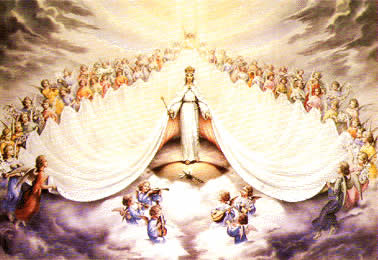
I believe that through Her death
the fault of my soul shall perish,
And I believe, through Her triumphant life,
My soul shall rise renewed in her perfection
that she may return to eternal communion
with the One eternal Dea.
This final Statement of the Creed weaves together, again with astonishing brevity, all the threads that have been spun. The History of the Soul is concluded. The Problem of Maid has its true resolution. The Sacred Drama of the Divine Sacrifice ends with its triumphant victory over maid's suffering. The Trinity, having been adored in each of Her Persons, is again seen in the perspective of Her fundamental Unity; and all things are resolved in that Final Blissful Union in which all beings are saved, "even to the last blade of grass."
The Filianic Creed expresses in the most concise and elegant manner, the whole essence of the Filianic faith. If one learns the Creed, one knows the religion, even though many more pages of commentary might be written than the few simple expositions we have attempted to give here.
But the Creed is more than an intellectual tool. It is in itself an act of devotion, expressing our faith, our love and our adoration. Reminding us of the journey of our own soul and of the infinite kindness and compassion of Dea.
The Creed of Dea can be summed up in one simple statement:
I believe in God the Mother.
If you can make this statement and you also love Her – or even want to love Her – then you have all that is necessary.
The Filianic Creed expands this simple "I believe" into a much greater – but still simple – statement of the entire Sacred Drama, from Creation to final Redemption, and of the pure doctrine of the Holy Feminine Trinity.
Please say with us, "I believe..."
See also:
The Catechism of the Children of Dea: The complete faith of Feminine Trinitarianism in Q&A form
Feminine Trinitarianism: A thealogical discussion of the Filianic doctrine of the Trinity
The Three Fates and Other Reflections of the Feminine Holy Trinity
Read your Bible: The Gospel of Our Mother God"
Send Questions or Comments on I Believe: the Filianic Creed
Go to top of page – I Believe: the Filianic Creed
Chapel of Our Mother God Homepage
All written material on this site is copyright. Should you wish to reproduce any portion please contact us for permission.
YouTube or Facebook
This section:
Fundamental Beliefs
A complete guide to the faith of God the Mother
FILIANIC SCRIPTURES
Gospel of Our Mother God
The Gospel of Our Mother God is a collection of inspirational texts, prayers and daily inspiration for the Mother-Faith devotee or household.
The Feminine Universe
The Other Philosophy
Everything you have ever heard comes out of the patriarchal world-view. Its materialism, its religion, even its feminism. Here is the other way of seeing the world; the natural way: the way that everyone saw things before patriarchy and will again when patriarchy is long forgotten.
